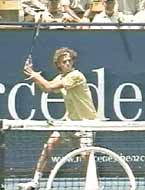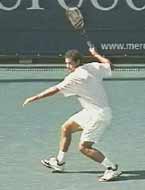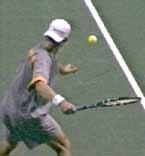<% ns_puts [mkm_getnavbar] %>
Building the Modern Forehand
Part 2: The BackSwing
by John Yandell
|
|
In the first article on the
Modern Forehand we examined the surprising technical commonalities
across the grip styles. These included the turn, the hitting arm position,
the set up, and the universal finish position.
However we noted that besides these common elements, there were significant
technical differences in the forehands. So in the next two articles, I'll
examine the differences in the swing patterns across the range of grips:
from Pete Sampras, to Andre Agassi to Gustavo Kuerten, and to Tommy Haas.
In this article, let’s start with the surprising variety of shapes and sizes of backswings. In the next article, we’ll look at the differences in the forward swing, from the completion of the backswing through the end of the stroke.
The Backswing
Top players have many things in common on the forehand, regardless of
grip style, but the backswing isn’t one of them. Take the racquet up and
back in a loop, drop it down, and swing, how complicated could it be? In
reality the backswing turns out to be the most complex and varied element in
the modern forehand.
When we look closely at the high speed video, we see no two players look
alike. The closer we look, the more different they appear. The players are
all highly individualistic and have bewildering combinations of shapes and
sizes.
Some of the motions are much more elaborate than others. It turns out there
is no simple way to describe them. There are some, limited commonalities,
but also extensive differences. Really understanding it all takes a
surprising amount of time and effort.
|
|
But how significant are these differences from a technical point of view?
Do some pro players have an advantage in terms of racquet head speed or
timing? Should players at other levels try to figure that out and copy them?
Obviously every player needs to develop a backswing. The question is what
should it look like? How important is the type of backswing to the
effectiveness of the stroke of the average player?
We might suppose that players with the more extreme grips have larger
backswings, but is it really true? What about backswing shapes? Do the more
complex shapes also pair with the extreme grips?
In addition to the complexity of some of the motions, another problem is
that they happen so fast, they are almost impossible to see accurately with
the naked eye. It takes pro players less than a second to get from the start
of the motion to the contact.
The only way to really see what is happening is to do detailed video
analysis. So let’s take a close look at the
Advanced Tennis
high speed footage and see what is really happening.
Amazingly we’ll find there are no less than 6 factors that go into the pro
backswing, all of which can vary widely from one player to another.
Six Components of the Pro Backswing
- The movement upward, or the height of the backswing
- The movement backward, or away from the body
- The side to side movement, both on the way up and the way down
- The closure of the racquet face in the upward motion
- The closure of the racquet face in the downward motion
- The timing in reaching the hitting arm position
It’s been argued in the coaching community that the backswing is a matter of personal style. That is certainly true. But it doesn’t mean the differences aren’t worth exploring and understanding. This process is the only way to shed light on decisions about size and shape that coaches and players make everyday.
|
Want to evaluate the pro
backswings on the forehand for yourself—as well as all the rest of the
strokes in high speed video? |
Backswing Size
You might think that just looking at the backswings of different players
and
evaluating the size of the swing would be one thing you could see
fairly easily with the naked eye.
But it actually turns out to be quite difficult and somewhat inconclusive,
even analyzing the high speed video.
First of all, what actually determines the “size?" Is it primarily the
height?
In addition to moving upwards, the racquet also moves in two other
directions during the course of the motion: backward, and to a lesser
extent, from side to side. How does the movement in each of these three
dimensions contribute to backswing size?
Let’s look first at “height.” That sounds simple, but how do we measure it? Do we look at the height of the racquet hand, or the height of the racquet itself?
|
|
But if we look at the other possible measure, the height of the racquet, suddenly the two players look very different. Hewitt has a high hand position. He also has the highest racquet position of any player, with the tip usually reaching 2 feet or more above the top of his head at the top of the backswing.
Roddick also has a high hand position. But, unlike Hewitt, he combines this
with a very low racquet tip position. In fact, Roddick has the lowest
racquet position of any player, with the tip at almost the same level as his
racquet hand.
How can this be possible? How can Roddick have the highest hand position and
the lowest racquet tip position at the same time? What the video shows is
that racquet height and hand height are independent variables.
Rather than pointing straight upward like Hewitt, Roddick points the racquet
tip directly forward at the top of his motion, with the shaft of his racquet
literally parallel to the court! This puts the racquet at virtually the same
height as his racquet hand.
The fact is that all of the players point the tip of the racquet in slightly
different or very different directions at the top of the backswing.
Just because a player has a high hand position, it doesn’t mean his racquet
tip will be high as well. Conversely a player can have a fairly low hand
position, but the racquet tip can be quite high depending on where it is
pointing at the top of the motion.
What this means when we look across the grip styles, is that every player
has his own unique combination of racquet and hand height.
Tommy Haas, for example, has the lowest hand position by far, usually
between chest and shoulder level. But the top of the backswing, he points
his racquet at an angle backward and upward, so that the tip of his racquet
is actually higher than Roddick’s, who has a much higher hand position.
Guga also has a fairly low hand position, usually shoulder level or a little
higher. But Guga points his racquet straight up at the top of the backswing,
making the tip of his racquet higher than Tommy’s even though there’s not a
huge difference in the hand position.
Backswing height based on the hand: from lowest to highest




| 1. Haas | 2. Guga | 3. Safin | 4. Agassi |



| 5. Pete | 6. Roddick | 7. Hewitt |
Marat Safin has a hand position that is usually slightly higher than Guga,
but has a lower racquet tip position. This is because at the top of his
backswing, he tilts the tip of his racquet forward.
Agassi and Sampras both have fairly high hand positions, at about eye level
or sometimes higher. But Pete’s racquet tip reaches higher, since it points
more straight up and down. Agassi’s racquet tip points forward like Safin’s
and also tilts a little more to the side.
Backswing height based on the racquet: from lowest to highest




| 1. Roddick | 2. Haas | 3. Safin | 4. Guga |



| 5. Agassi | 6. Pete | 7. Hewitt |
Movement Backwards
So measuring backswing height, the results are ambiguous at best. What about
the second dimension in overall backswing size--how far the racquet moves
back away from the player toward the rear of the court?
Again we find there are variations from player to player that don’t seem to
correlate at all with their grips or any other factor in their backswings.
|
|
Just as at the top of the backswing, there are also significant differences
in the position and angle of the hand and the position and angle of the
racquet.
At the furthest point in the backward movement, Agassi and Pete both have
their hands at about shoulder level or a little lower. They both seem to
straighten there arms out slightly more than most of the other players. Both
also point the tip of the racquet backwards and upwards at a slight angle,
with the face of the racquet slightly closed.
Haas looks very similar to Agassi and Pete in terms of height and direction the racquet points.
He may straighten out his arm slightly more and reach further backwards.
His racquet face is also closed much further than Pete or Andre.
At the furthest point behind him, Hewitt’s racquet hand is usually still
above shoulder level, with the tip of the racquet pointing upward at about
45 degrees, and also pointing at an angle behind him to his left. Sometimes
he straightens his arm out completely, even more than Pete or Agassi, but
most times it remains bent at the elbow at about 30 degrees or more.
Movement backwards in the backswing: from least to most




| 1. Roddick | 2. Safin | 3. Guga | 4. Hewitt |



| 5. Pete | 6. Agassi | 7. Haas |
Guga’s racquet hand is much lower than Hewitt’s, about midway between the
shoulders and the waist. But like Hewitt, his racquet tip also points at an
angle behind him and to his left.
Safin and Roddick are at about the same hand height as Guga. Unlike Guga,
however, they both point the tip of the racquet to their right side, rather
than to the left. Roddick points his slightly further to the right than
Marat.
Confused yet? Just wait until we examine the sideways component of the
movement.
|
Want to study high speed video of
the modern forehand for yourself (as well as all the other
strokes)? |
Your comments are welcome. Let us know what you think about John Yandell's article by emailing us here at TennisONE.
 John
Yandell is TennisONE's CEO as well as a Special Contributing Editor. John
Yandell is TennisONE's CEO as well as a Special Contributing Editor. John Yandell has directed instructional videos with numerous top coaches and players including, Jim Loehr, Allen Fox, Pat Etcheberry, Dick Gould, Frank Brennan, John McEnroe and Ivan Lendl. |
To contact us, please email to: webmaster@tennisone.com
TennisONE is a registered trademark of TennisONE and SportsWeb ONE; Copyright 1995. All rights reserved.





